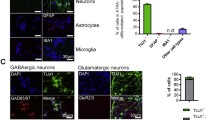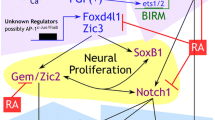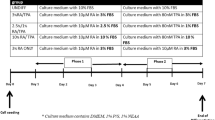Abstract
In mature cells of the sympathetic nervous system and the adrenal gland, the activity of dihydroxyphenylalanine decarboxylase (DDC) is higher than that of tyrosine hydroxylase and 3,4-dihydroxyphenylalanine (DOPA) does not accumulate in the cells. On the other hand, it is known that in some neuroblastoma cells there is a relative deficiency of DDC, resulting in accumulation and secretion of DOPA. Such a relative deficiency of DDC is a characteristic of neural cells at an early stage of neural crest development, suggesting the neuroblastoma are cells arrested in early neural crest development. If this were the case, it is possible that agents such as retinoic acid (RA) could induce neuroblastoma to differentiate into mature cells with respect to their metabolism of catecholamines. We have measured the effect of RA on the metabolism of DOPA and expression of tyrosine hydroxylase and DDC in human neuroblastoma cell lines, CHP-126, CHP-134, IMR-32, NB-59, and LA-N-5. When the cell cultures were treated with RA, they showed wide variations in response as measured by morphological change, growth inhibition, enzyme activities and DDC, but does not increase DDC relative to tyrosine hydroxylase. It is concluded that RA does not induce biochemical differentiation of the neuroblastoma into mature cells even when there are extensive morphological changes and suppression of growth rate.
Similar content being viewed by others
References
Ross, R. A., Spengler, B. A., and Biedler, J. L. 1983. Coordinate morphological and biochemical interconversion of human neuroblastoma cells. J. Natl. Cancer Inst. 71:741–749.
Ciccarone, V., Spengler, B. A., Meyers, M. B., Biedler, J. L., and Ross, R. A. 1989. Phenotypic diversification in human neuroblastoma cells: expression of distinct neural crest lineages. Cancer Res. 49:219–225.
Sugimoto, T., Sawada, T., Horii, Y., Kemshead, J. T., Hino, T., Morioka, H., and Hosoi, H. 1988. Schwannian cell differentiation of human neuroblastoma cell lines in vitro induced by bromodeoxyuridine. Cancer Res. 48:2531–2537.
Tsokos, M., Scarpa, S., Ross, R. A., and Triche, T. J. 1987. Differentiation of human neuroblastoma recapitulates neural crest development. Am. J. Pathol. 128:484–496.
Ross, R. A., Biedler, J. L., Spengler, B. A., and Ries, D. J. 1981. Neurotransmitter-synthesizing enzymes in 14 human neuroblastoma cell lines. Cell. Mol. Neurobiol. 1:301–312.
Mena, M. A., de Yebenes, J. C., Dwork, A., Fahn, S., Latov, N., Herbert, J., Flaster, E., and Sionim, D. 1989. Biochemical properties of monoamine-rich human neuroblastoma cells. Brain Res. 486:286–296.
Singh, I. N., Sorrentino, G., McCartney, D. G., Massarelli, R., and Kanfer, J. N. 1990. Enzymatic activities during differentiation of the human neuroblastoma cells, LA-N-1 and LA-N-2. J. Neurosci. Res. 25:476–485.
Pennypacker, K. R., Kuhn, D. M., and Billingsley, M.L. 1989. Changes in expression of tyrosine hydroxylase immunoreactivity in human SMS-KCNR neuroblastoma following retinoic acid or phorbol ester-induced differentiation. Mol. Brain Res. 5:251–258.
Cooper, J. R., Bloom, F. E., and Roth, R. H. 1982. The biochemical basis of neuropharmacology, pp. 128–135. New York, NY: Oxford University Press, Inc.
Messripour, M. and Clark, J. B. 1982. Tyrosine hydroxylase activity in rat brain synaptosomes: direct measurement using high performance liquid chromatography. J. Neurochem. 38:1139–1143.
Nissbrandt, H., Engberg, G., Wikstrom, H., Magnusson, T., and Carlsson, A. 1988. NSD1034: an amino acid decarboxylase inhibitor with a stimulatory action on dopamine synthesis not mediated by classical dopamine receptors. Naunyn Schmiedebergs Arch. Pharmacol. 338:148–161.
Hirata, Y., Togari, A., and Nagasu, T. 1983. Studies on tyrosine hydroxylase system in rat brain slices using high-performance liquid chromatography with electrochemical detection. J. Neurochem. 40:1585–1589.
Waymire, J. C. and Gilmer-Waynire, K. 1978. Adrenergic enzymes in cultured mouse neuroblastoma: absence of detectable aromatic-L-amino-acid decarboxylase. J. Neurochem. 31:693–698.
Boomsma, F., Ausema, L., Hakvoort-cammel, F. G., Oosterom, R., Mnin'tveld, A. J., Krenning, E. P., Hahlen, K., and Schalekamp, M. A. 1989. Combined measurements of plasma aromatic L-amino acid decarboxylase and DOPA as tumour markers in diagnosis and follow-up of neuroblastoma. Eur. J. Cancer Clin. Oncol. 25:1045–1052.
Abramowsky, C. R., Taylor, S. R., Anton, A. H., Berk, A. I., Roederer, M., and Murphy, R. F. 1989. Flow cytometry DNA ploidy analysis and catecholamine secretion profiles in neuroblastoma. Cancer. 63:1752–1756.
Goldstein, D. S., Stull, R., Eisenhofer, G., Sisson, J. C., Weder, A., Averbuch, S. D., and Keiser, H. R. 1986. Plasma 3,4-dihydroxyphenylalanine(dopa) and catecholamines in neuroblastoma or pheochromocytoma. Ann. Intern. Med. 105:887–888.
Gazdar, A. F., Helman, L. J., Israel, M. A., Russell, E. K., Linnoila, R. I., Mulshine, J. L., Schuller, H. M., and Park, J. 1988. Expression of neuroendocrine cell markers L-dopa decarboxylase, chromogranin A, and dense core granules in human tumors of endocrine and nonendocrine origin. Cancer Res. 48:4078–4082.
Yee, D. K., Pastuszko, A., Nelson, D., and Wilson, D. F. 1989. Effects of DL-2-amino-5-phosphonovalerate on metabolism of catecholamines in synaptosomes from rat brain. J. Neurochem. 52: 54–60.
Gerhardt, G. A. 1989. Enzymatic digestion of biological samples for improved determination of monoamines and monoamine metabolites by HPLC with electrochemical detection. LC GC. 7:770–774.
Lowry, O.H., Rosebrough, N.J., Farr, A.L., and Randall, R.J. 1951. Protein measurement with the folin phenol reagent. J. Biol. Chem. 193:265–275.
Sidell, N., Altman A., Haussler, M. R., and Seeger, R.C. 1983. Effects of reveral human neuroblastoma cell lines. Exp. Cell Res. 148:21–30.
Ikegaki, N., and Kennett, R. H. 1989. Glutaraldehyde fixation of the primary antibody-antigen complex on nitrocellulose paper increases the overall sensitivity of immunoblot assay. J. Immunol. Methods. 124:205–210.
LeDouarin, N. 1982. The neural crest, pp. 212–215. Cambridge: Cambridge University Press.
Bronner-Fraser, M. and Fraser, S. E. 1988. Cell lineage analysis reveals multipotency of some avian neural crest cells. Nature. 335: 161–164.
Baroffio, A., Dupin, E., and Le Douarin, N. M. 1988. Clone-forming ability and differentiation potential of migratory neural crest cells. Proc. Natl. Acad. Sci. USA. 85:5325–5329.
Le Douarin, N. M. 1986. Cell line segregation during peripheral nervous system ontogeny. Science. 231:1515–1522.
Jonakait, G. M., and Black, I. B. 1988. Regulation of catecholamine development. In: Trendelenburg, U., and Weiner, N. (eds.), Catecholamines, Vol. 2, pp. 137–179. New York, NY: Springer-Verlag.
Teitelman, G., Jaeger, C. B., Albert, V., Joh, T. H., and Reis, D. J. 1983. Expression of amino acid decarboxylase in proliferating cells of the neural tube and notochord of developing rat embryo. J. Neurosci. 3:1379–1388.
Blomhoff, R., Green, M. H., Berg, T., and Norum K. R. 1990. Transport and storage of vitamin A. Science 250:399–404.
Petkovich, M., Brand, N. J., Krust, A., and Chambon, P. 1987. A human retinoic acid receptor which belongs to the family of nuclear receptors. Nature. 330:444–450.
Giguere, V., Ong, E. S., Segui, P., and Evans, R. M. 1987. Identification of a receptor for the morphogen retinoic acid. Nature. 330:624–629.
de The, H., Vivanco-Ruiz, M. M., Tiollais, P., Stunnenberg, H., and Dejean, A. 1990. Identification of a retinoic acid responsive element in the retinoic acid receptor β gene. Nature 343:177–180.
Chiocca, E. A., Davies, P. J. A., and Stein, J. P. 1988. The molecular basis of retinoic acid action. J. Biol. Chem. 263:11584–11589.
Masserano, J. M., Vulliet, P. R., tank, A. W., and Weiner, N. 1988. The role of tyrosine hydroxylase in the regulation of catecholamine synthesis. In: Trendelenburg, U., and Weiner, N. (eds.), Catecholamines, Vol. 2, pp. 427–469. New York, NY: Springer-Verlag.
Makowske, M., Ballester, R., Cayre, Y. and Rosen, O. M. 1988. Immunochemical evidence that three protein kinase C isozymes increase in abundance during HL-60 differentiation induced by dimethyl sulfoxide and retinoic acid. J. Biol. Chem. 263:3402–3410.
Pratt, M. A. C., Kralova, J., and McBurney, M. W. 1990. A dominant negative mutation of the alpha retinoic acid receptor gene in a retinoic acid-nonresponsive embryonal carcinoma cell. Mol. Cell. Biol. 10:6445–6453.
Author information
Authors and Affiliations
Rights and permissions
About this article
Cite this article
Ikeda, H., Pastuszko, A., Ikegaki, N. et al. 3,4-Dihydroxyphenylalanine (DOPA) metabolism and retinoic acid induced differentiation in human neuroblastoma. Neurochem Res 19, 1487–1494 (1994). https://doi.org/10.1007/BF00968995
Accepted:
Issue Date:
DOI: https://doi.org/10.1007/BF00968995




